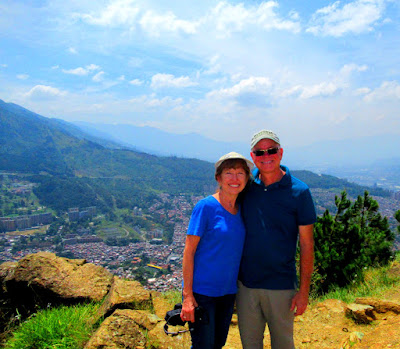 |
| Photo credit: Picasa |
Café ... Cappuccino ... Java ... Morning Joe. No matter how you say it, to a coffee lover, there is nothing more precious than that morning cup of coffee. Add the name of an exotic country of origin like Costa Rica, Ethiopia, or Colombia to the label ... and that cup of coffee instantly reaches superstar level!
For a coffee lover, a visit to Colombia is not complete without a visit to see the origins of their beloved brew. So when Jill (certifiable coffee connoisseur) visited us in Medellín, she had one request that I was very happy to fulfill ...
Let's journey high into the Andes Mountains of Antioquia for a Colombian Coffee Farm Tour!
We booked our tour through Toucan, the school where we took Spanish lessons last year. Transportation, English-speaking guide, breakfast, lunch, coffee tour, and tastings cost $70 a person. Toucan has a café in which they brew delicious cups of coffee, and they also have a coffee museum that highlights fun facts about this amazing drink. It is there that we met our group and guide, Fernando. An hour and half van ride brought us over the mountains south of Medellín to the town of Fredonia. From there we loaded into two 4x4 vehicles to complete our journey up twisty, narrow roads that brought us higher into the fertile mountains that produce some of Colombia's best coffee.
Walking the last half mile up to the coffee finca (farm) house just added to the ''authenticity'' of the experience. Humberto Pareja and his wife welcomed us to his family-run coffee business, Café de la Cima (Summit Coffee). We sat down to enjoy a homemade arepa de choclo con queso breakfast and our first of many delicious cups of liquid heaven.
With our guide Fernando acting as our interpreter, Humberto began to explain the labor-intensive process that ensures that we can enjoy our daily caffeine fix. Colombia produces 15% of the world's coffee. High in the Andes Mountains, the perfect blend of sun, precipitation, and soil conditions produces the red Arabica beans that Colombian coffee is famous for.
After introducing us to the process, it was time to get to work. Donned with our sombreros and baskets, we climbed up the hillside for the coffee bean picking experience.
The best coffee is hand-picked to ensure that only the ripest, most flavorful beans are used. Trying to keep my footing while reaching deep into the bushes in search of those deep red coffee cherries proved to be a challenge. A skilled harvester can pick more than 100 pounds of beans a day.
My haul after 30 minutes of ''work'' leaves a lot to be desired!
I will blame it on being side tracked by the amazing views. Recognize the pyramid-shaped mountain in the distance? It, along with ''Juan Valdez'', is the inspiration for the Colombian Coffee Federation symbol.
Once picked, the beans need to be immediately processed. The pulp from the coffee cherry is removed, and the seeds washed and sorted according to their size and weight. Those beans that don't meet the stringent requirements (not ripe enough or too small) are not just thrown away. They end up being sold to companies that make instant coffee. With this new knowledge, it's going to take a lot of convincing to get us to drink a cup of instant coffee again!
The beans are dried in the warm Colombian sun and put into jute bags that are shipped to local and international roasters. After subtracting the costs to grow, pick, and process these beans, the average coffee farmer can hope to make only about 30,000 cop (less than $10 usd) per 70 kg bag. That is one of the reasons that Humberto and his family branched out into the coffee roasting and coffee tourism business.
He led us into the coffee ''laboratory'' where his seemingly simple roasting set-up is actually more of a science than first meets the eye. The combination of precise temperatures and exact roasting times produces the rich flavor and velvety aroma that Colombian coffee is famous for.
After a delicious ''bandeja paisa'' lunch that included soup, beef, rice, plantain, salad, empanada, and coffee lemonade (very ''interesting'', but not sure that I am a fan), we began the coffee tasting portion of our tour.
Five types of beans were used to prepare five different cups of coffee. The first step was to judge the quality of the beans based on the aroma. Each sample was just a little different with cup #3 being our favorite and cup #5 being our least favorite. After that it was time for the taste test. As we took small sips, Humberto skillfully explained what qualities we should be noting. Cup #3 was still our favorite, and we were happy to find out that our favorite was also Café de la Cima's best product. Our least favorite, cup #5, contained the coffee beans that end up in the instant coffee brands.
Feeling pleased that we were becoming coffee tasting ''experts'', it was time to learn how to brew our favorite beverage. Humberto showed us once again how proper water temperature and brewing time produced the perfect cup of coffee. While his brewing methods were a little more sophisticated than what we usually do when using our ''Mr Coffee'' coffee maker, we took his advice to heart ... The best cup of coffee begins with the best Colombian coffee beans.
And for us, the best beans were found ...
High in the Andes Mountains of Antioquia during our Colombian coffee farm tour!




























































